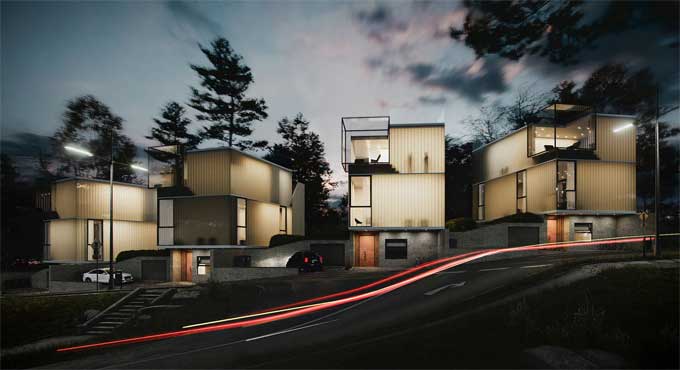3D Architectural Renderings in 2023 for Marketing and Postproduction

Visual effects and textures are added to rendered images using image processing software in postproduction. It becomes easier to adapt to last minute changes or render different material versions in a quickly time by using various techniques. The process of rendering is often performed without adjusting lighting, materials, or textures by professionals using image processing programs.
Define Postproduction in 3D Architectural Rendering
During the postproduction process of 3D architectural rendering, the 3D architectural rendering expert uses specialized software to process a rendered image. A 3D architectural visualization service is enhanced with the final finishing touches of this process. Artists utilize this stage to combine a render with photos, add special effects, and adjust its visual attributes.
Light-room and Adobe Photoshop are often used instead of 3D software for this process. For 3D architectural visualization services, post production assists artists in creating lifelike and photorealistic CG renders.
Camera Effects Addition
Beveling
In nature, there are no sharp edges on objects, so a quality driven and reliable architectural visualization company reminds its team of this constantly. It is one of the most common mistakes made by new 3D architectural rendering experts to leave the edges as they are, and this can ruin the presentation. Once texturing and rendering are complete, it is essential to bevel them. These small touches add even more value to photorealistic 3D visualizations.
Noise
A 3D render that incorporates noise can better resemble real camera images.
Glow, Glare and Bloom
The glow of a light makes things shine and glare is the effect of a bright light that obscures part of an image. In real life, glare occurs whenever light is shone upon a reflecting surface in a frame.
Finally, bloom produces the elements of light that bleed from the boundaries of bright areas in an image in the context of 3D architecture visualisation services. Bloom is accustomed to adding dramatic lighting, especially in 3D interior rendering services, to improve the architectural visualization's overall aesthetic appeal.
The render comes to life thanks to this effect, which also makes it more visually engaging for spectators. Key design aspects in the architectural visualisation can be efficiently highlighted by light patches produced by bloom that draw attention to certain items.
Presets and filters
In order to give the image a distinctive ambiance during postproduction, the artist can also employ presets and filters. The purpose of vignetting is to make an image's borders darker and blurrier. Lens presets, chromatic effects, lens flares, and distortions all mimic the imperfections of a real camera.
Motion Blur
The term motion blur describes the blurring of specific objects in a scene to make them appear to be moving. When a building's model is compared to moving objects in a 3D architectural visualisation, the contrast has more impact. It gives the render the appearance of a long exposure camera shot.
Field Depth
Within 3D architectural visualisation services and independent architectural presentation services, the depth of field effect blurs the background to contrast with the foreground, effectively identifying the areas of the image that are in focus. The good news is that while creating a blurred background effect can be done quite simply, it is also very beneficial and successful in boosting the visual presentation of architectural renders for both professional and independent architectural presentation services.
For starters, the depth of field effect enhances the perception of the architectural visualization's quality by giving the impression that it was shot with a professional camera. It also aids in differentiating important design components, drawing attention to them, and emphasising important aspects of the architectural area. Incorporating this effect into 3D architecture animation services can also work like magic, enhancing the architectural visualisation experience by providing a lively and eye catching feature.
Age and Grunge Addition
Those buildings that appear flawless from a distance do not look spotless or perfect. To avoid unrealistic effects, architectural 3D model designers might apply aging to some materials, such as metals or leather, natural cracks to stone or wood, etc. Clients would consider the last time they saw something similar to the project, adding to its impression of extra realism.
Colour Correction
The artist that specialises in photorealistic rendering services will run the 3D building rendering through Photoshop after it is finished to rectify any colour issues. The colours must appear authentic rather than being drawn from a pre-set palette. Artists can improve the object realism and colour vibrancy by making even minor changes to curves or levels. This raises the overall standard and aesthetic appeal of photorealistic rendering services.
To learn more, watch the following video tutorial.
Video Source: Balkan Architect
Wrapping it Up
Hyper realistic 3D representations are used by architectural firms to present design concepts to clients. These renderings, which are produced using sophisticated software, go through several steps including 3D modeling, rendering, and post-production. Professionals enhance photos in postproduction using programs like Light-room and Photoshop to produce lifelike visualizations.
There are many techniques that can be used, including black and white matching, weather effects, color grading, tone mapping, and camera effects such as glare, bloom, and depth of field. Grunge and beveling, two little touches that boost realism, make marketing tools more useful.
By incorporating these methods into their 3D architectural visualization and animation services, businesses may engage audiences, highlight design details, and improve marketing and project presentations.



